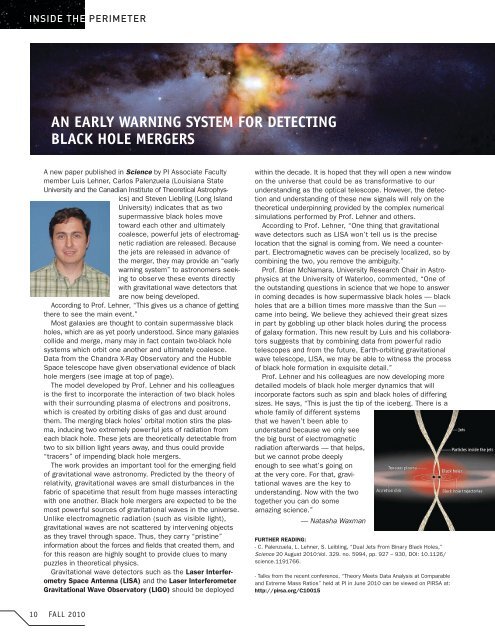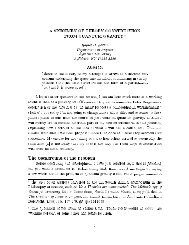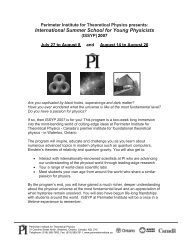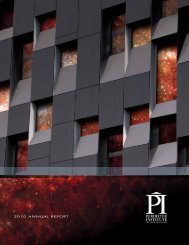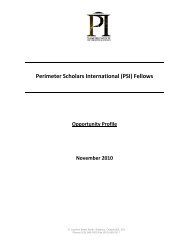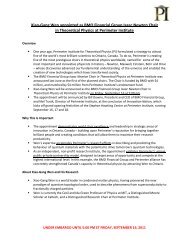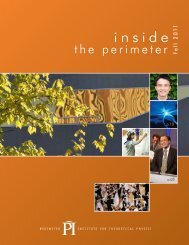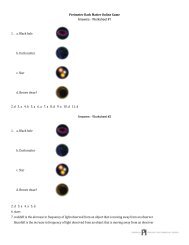whaT's InsIde - Perimeter Institute
whaT's InsIde - Perimeter Institute
whaT's InsIde - Perimeter Institute
- No tags were found...
Create successful ePaper yourself
Turn your PDF publications into a flip-book with our unique Google optimized e-Paper software.
<strong>InsIde</strong> the PerImeteran early warnIng sysTem For deTeCTIngblaCK hole mergersA new paper published in Science by PI Associate Facultymember Luis Lehner, Carlos Palenzuela (Louisiana StateUniversity and the Canadian <strong>Institute</strong> of Theoretical Astrophysics)and Steven Liebling (Long IslandUniversity) indicates that as twosupermassive black holes movetoward each other and ultimatelycoalesce, powerful jets of electromagneticradiation are released. Becausethe jets are released in advance ofthe merger, they may provide an “earlywarning system” to astronomers seekingto observe these events directlywith gravitational wave detectors thatare now being developed.According to Prof. Lehner, “This gives us a chance of gettingthere to see the main event.”Most galaxies are thought to contain supermassive blackholes, which are as yet poorly understood. Since many galaxiescollide and merge, many may in fact contain two-black holesystems which orbit one another and ultimately coalesce.Data from the Chandra X-Ray Observatory and the HubbleSpace telescope have given observational evidence of blackhole mergers (see image at top of page).The model developed by Prof. Lehner and his colleaguesis the first to incorporate the interaction of two black holeswith their surrounding plasma of electrons and positrons,which is created by orbiting disks of gas and dust aroundthem. The merging black holes’ orbital motion stirs the plasma,inducing two extremely powerful jets of radiation fromeach black hole. These jets are theoretically detectable fromtwo to six billion light years away, and thus could provide“tracers” of impending black hole mergers.The work provides an important tool for the emerging fieldof gravitational wave astronomy. Predicted by the theory ofrelativity, gravitational waves are small disturbances in thefabric of spacetime that result from huge masses interactingwith one another. Black hole mergers are expected to be themost powerful sources of gravitational waves in the universe.Unlike electromagnetic radiation (such as visible light),gravitational waves are not scattered by intervening objectsas they travel through space. Thus, they carry “pristine”information about the forces and fields that created them, andfor this reason are highly sought to provide clues to manypuzzles in theoretical physics.Gravitational wave detectors such as the Laser InterferometrySpace Antenna (LISA) and the Laser Interferometergravitational Wave Observatory (LIgO) should be deployedwithin the decade. It is hoped that they will open a new windowon the universe that could be as transformative to ourunderstanding as the optical telescope. However, the detectionand understanding of these new signals will rely on thetheoretical underpinning provided by the complex numericalsimulations performed by Prof. Lehner and others.According to Prof. Lehner, “One thing that gravitationalwave detectors such as LISA won’t tell us is the preciselocation that the signal is coming from. We need a counterpart.Electromagnetic waves can be precisely localized, so bycombining the two, you remove the ambiguity.”Prof. Brian McNamara, University Research Chair in Astrophysicsat the University of Waterloo, commented, “One ofthe outstanding questions in science that we hope to answerin coming decades is how supermassive black holes — blackholes that are a billion times more massive than the Sun —came into being. We believe they achieved their great sizesin part by gobbling up other black holes during the processof galaxy formation. This new result by Luis and his collaboratorssuggests that by combining data from powerful radiotelescopes and from the future, Earth-orbiting gravitationalwave telescope, LISA, we may be able to witness the processof black hole formation in exquisite detail.”Prof. Lehner and his colleagues are now developing moredetailed models of black hole merger dynamics that willincorporate factors such as spin and black holes of differingsizes. He says, “This is just the tip of the iceberg. There is awhole family of different systemsthat we haven’t been able tounderstand because we only seethe big burst of electromagneticradiation afterwards — that helps,but we cannot probe deeplyenough to see what’s going onat the very core. For that, gravitationalwaves are the key tounderstanding. Now with the twotogether you can do someamazing science.”— Natasha WaxmanFURTHeR ReADINg:- C. Palenzuela, L. Lehner, S. Leibling, “Dual Jets From Binary Black Holes,”Science 20 August 2010:Vol. 329. no. 5994, pp. 927 – 930, DOI: 10.1126/science.1191766.- Talks from the recent conference, “Theory Meets Data Analysis at Comparableand Extreme Mass Ratios” held at PI in June 2010 can be viewed on PIRSA at:http://pirsa.org/C1001510 Fall 2010


